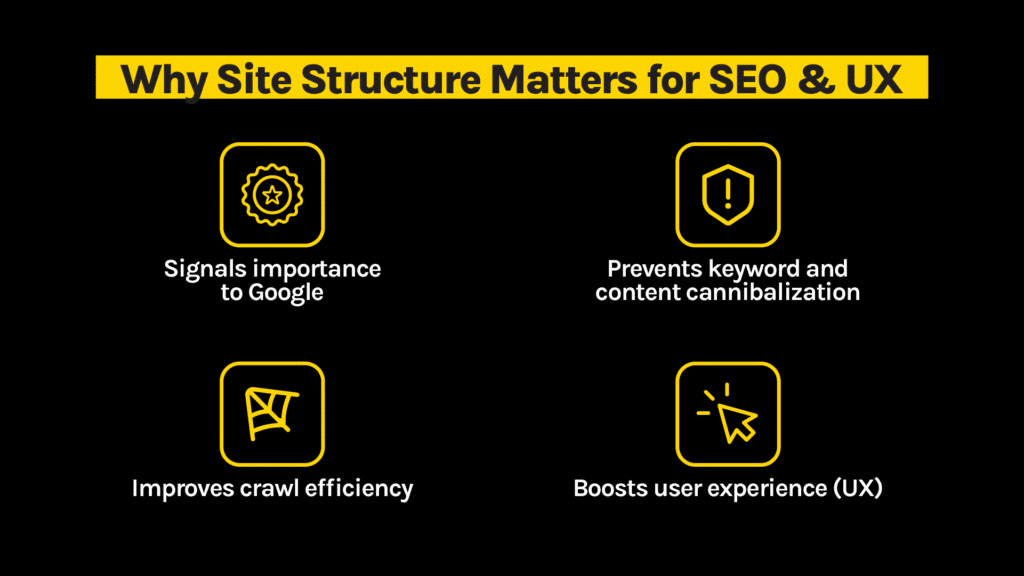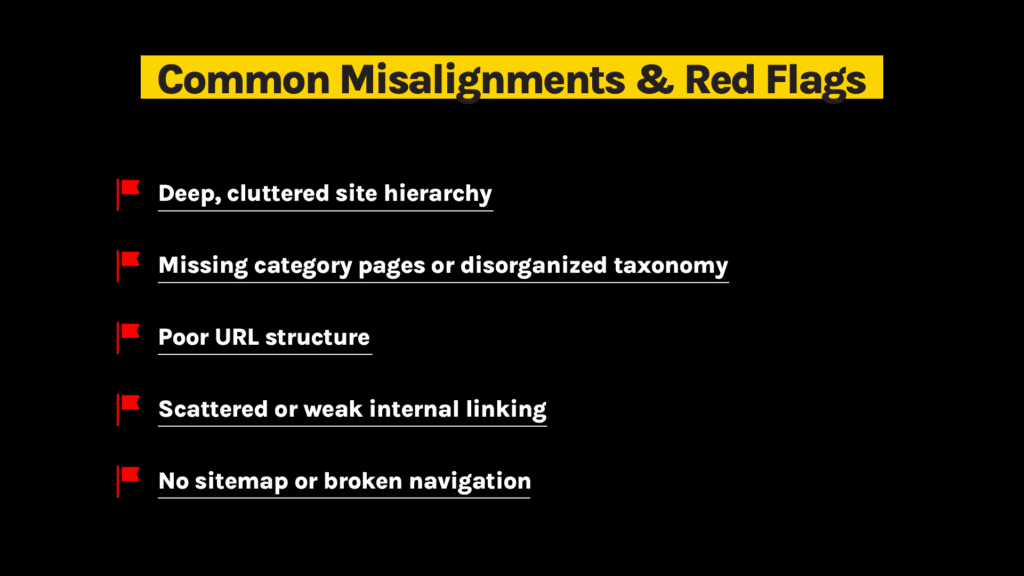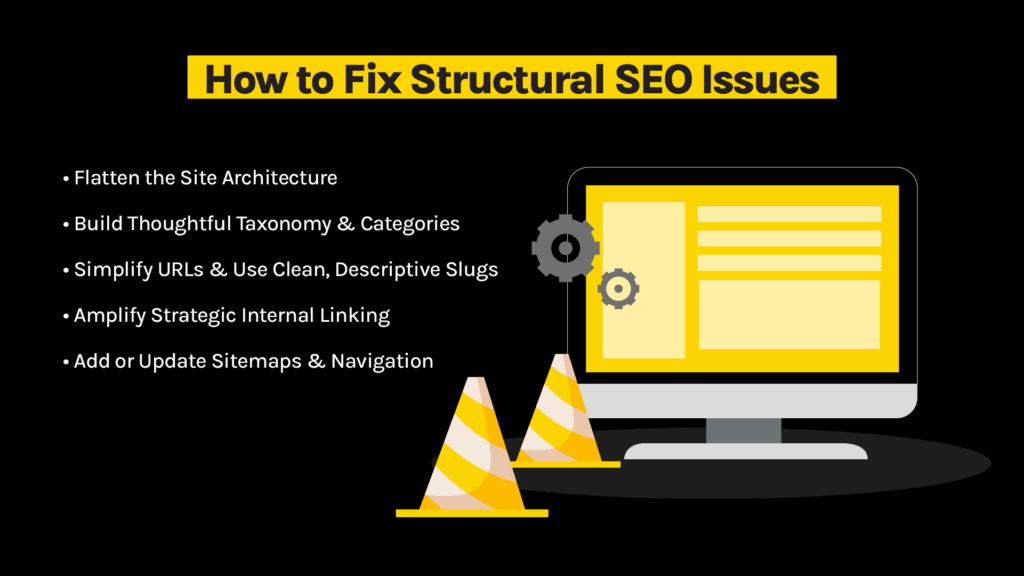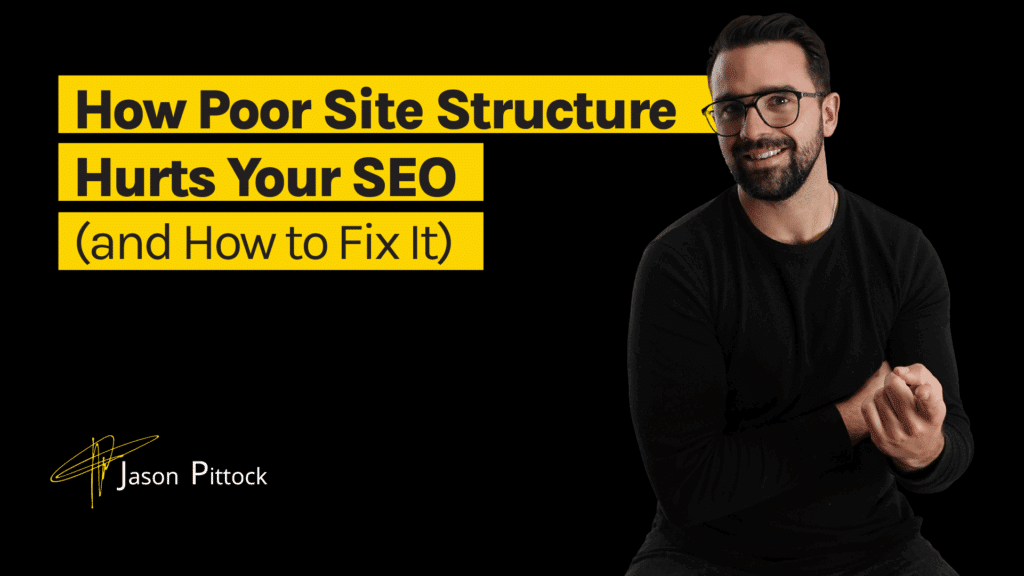You’ve published great content, but performance is flat. The keywords are there. The backlinks are coming in. But your rankings? Stuck. Traffic? Barely moving. Here’s the uncomfortable truth: the problem isn’t your content, it’s your site structure. If your website is a mess under the hood, no amount of content or backlinks will save you. Poor structure silently kills SEO performance, frustrates users, and leaves opportunity on the table.
And now, there’s another factor: large language models (LLMs) and AI-driven search. These systems rely heavily on clear, logical site structure to understand, categorize, and surface your content effectively. A disorganized site can limit your visibility in AI-driven search results just as much as in traditional rankings. This post breaks down why site structure is such a critical SEO factor and exactly how to fix it before your rankings (and AI visibility) flatline.
Why Site Structure Matters for SEO & UX
Most businesses obsess over content and backlinks while treating site structure as an afterthought. Big mistake. Your structure tells Google (and your visitors) what matters on your site. Get it wrong, and you confuse both.
Here’s what’s at stake:

- Signals importance to Google – Your hierarchy shows which pages are the most important. If everything lives on the same level, nothing stands out. That means your “money pages” compete with fluff content instead of getting the authority they deserve.
- Prevents keyword and content cannibalization – When similar pages fight for the same terms, Google has no idea which one to rank. Clear structure (think pillar pages and topic clusters) eliminates the overlap and reinforces topical authority.
- Improves crawl efficiency – Googlebot doesn’t have infinite time. If your site is a maze of orphaned pages and dead ends, you waste crawl budget and risk having valuable content ignored.
- Boosts user experience (UX) – Visitors expect to find answers quickly. Poor navigation = high bounce rates. High bounce rates = a negative signal to Google. It’s all connected.
Put simply: bad structure makes your content invisible. Good structure turns your site into a roadmap that guides both users and search engines exactly where you want them to go.
Common Misalignments & Red Flags
Even if you’ve got great content, the following structural issues will quietly sabotage your SEO performance:

- Deep, cluttered site hierarchy – If it takes more than 4–5 clicks from the homepage to reach key pages, you’re diluting PageRank and wasting crawl budget. Google doesn’t dig deep unless it has to, and neither do your users.
- Missing category pages or disorganized taxonomy – Without a logical category system, you create orphaned pages (no internal links pointing to them) and a frustrating navigation experience. If users can’t find your content, why should Google?
- Poor URL structure – example.com/page?id=12345 isn’t doing you any favors. URLs should be clean, descriptive, and reflect hierarchy (e.g., /blog/seo/site-structure). Messy URLs = lost trust and weaker relevance signals.
- Scattered or weak internal linking – Internal links aren’t decoration. They distribute authority, guide crawlers, and tell Google which pages matter most. Without a strategy, your cornerstone pages get buried under irrelevant fluff.
- No sitemap or broken navigation – If your XML sitemap is missing or outdated—or your nav links break—Google’s crawling efficiency tanks. An invisible page is basically a nonexistent page.
Diagnose Your Site: Quick Checks
Before you can fix site structure, you need to know what’s broken. Here’s a simple diagnostic process to surface red flags fast:

1. Run a Crawl
Use a tool like Screaming Frog or Sitebulb to crawl your site. Pay attention to:
- Pages buried more than 4 clicks deep
- Orphaned content (no internal links)
- Broken links that kill crawl flow
If your crawl report looks like spaghetti, your structure needs work.
2. Visualize Your Site Map
Draw or export a site map and look at the shape:
- Pyramid/fan structure = healthy
- Maze of deep paths = disaster
Your goal: every important page should be reachable within 4 clicks from the homepage. Anything deeper is practically invisible.
3. Review URL Patterns
Ask yourself:
- Are your URLs clean, keyword-rich, and descriptive?
- Do they reflect hierarchy (/category/subcategory/page) or are they random strings? Bad URL hygiene is a classic sign of neglected structure.
4. Audit Internal Linking
Check whether your cornerstone pages (the ones you want to rank) attract consistent, relevant links from within your site. If blog posts only link to each other and never to your money pages, you’re shooting yourself in the foot.
5. Confirm Sitemap & Navigation Health
- Ensure you have an updated XML sitemap submitted in Google Search Console.
- Include an HTML sitemap or clear navigation menu for users.
- Fix any broken or redirected links in your menus.
If Google can’t crawl it, it can’t rank it. End of story. Beyond traditional SEO, a clear sitemap and navigation also help AI-driven systems and large language models understand your site’s hierarchy and content relationships. This improves how your pages are interpreted and recommended in AI-powered search results, giving you an edge in emerging search technologies.
How to Fix Structural SEO Issues
This is where rankings move. Fix the structure, and everything else (crawl, indexing, UX, conversions) gets easier. Use the steps below as a checklist you can implement this week.

Flatten the Site Architecture
Reduce click depth and concentrate authority on pages that matter.
What to do
- Reorganize into a clear pyramid: Homepage → Categories (pillars) → Subcategories (sub-pillars) → Content (articles/product pages).
- Enforce “≤4 clicks” reachability: Any important page should be reachable in 4 clicks or less from the homepage. Aim for ≤3 for cornerstone pages.
- Promote key hubs in the header/nav: Feature your main category hubs in the global navigation; demote low-value links to footer or contextual placements.
- Add hub pages for big topics: If a category covers many subtopics, create a hub that summarizes and links to every subpage with short, descriptive blurbs.
- Merge or prune thin sections: If a section has few weak pages, consolidate into a single stronger resource or remove it. Don’t maintain empty “drawers.”
Quick wins
- Add a “Top Resources” or “Start Here” block on the homepage linking to 6–10 cornerstone pages.
- On each hub, add a “Most Popular” band linking to 4–6 top performers to reduce depth and send stronger internal signals.
- Mega menus that expose hundreds of links dilute internal PageRank. Keep it focused on priority categories.
- Avoid creating “fake depth” with unnecessary subfolders (e.g., /blog/blog/…, /category/category/…).
Build Thoughtful Taxonomy & Categories
Make the structure match how users search and how your business sells.
What to do
- Define topic pillars: List 6–12 core themes you want authority for. Those become categories (pillars).
- Cluster content intentionally: Map every article/product to one primary pillar. Use subcategories when volume warrants it (typically ≥15–20 closely related pages).
- One URL, one intent: If two pages target the same query, merge or reposition to avoid cannibalization.
- Standardize naming: Human-readable, consistent labels in nav, breadcrumbs, and headings (e.g., “Menopause Supplements,” not “Supplements—Meno” in one place and “Meno Care” in another).
- Handle faceted navigation: For ecommerce, allow crawl to meaningful facets (e.g., main brand or size) and block or canonicalize infinite combinations (color+price+size+tag soup).
Quick wins
- Create a taxonomy spreadsheet: columns for Pillar, Sub-pillar, Page, Primary Keyword, URL, Status. Assign every page a home.
- Turn “floating” content (orphans) into cluster members by linking them from the pillar hub.
- Don’t split similar topics across different categories because of org silos. Users (and Google) don’t care about your internal team chart.
Simplify URLs & Use Clean, Descriptive Slugs
Reflect hierarchy, improve relevance signals, and reduce duplication.
What to do
- Mirror your structure in URLs: example.com/services/web-design, not example.com/?p=123 or example.com/services/2020/07/web-design-article.
- Keep slugs short, lowercase, hyphenated: web-design-pricing, not Web_Design_Pricing_2025.
- Remove noise: No session IDs, tracking params, or dates in canonical URLs.
- Choose a canonical format and stick to it: Trailing slash policy, singular vs plural, and protocol (https://) should be consistent.
- Plan 301s carefully: When changing URLs, map 1:1, update all internal links, push new XML sitemaps, and monitor 404s.
Quick wins
- Rewrite long, keyword-stuffed slugs into concise phrases (40–60 characters is plenty).
- Consolidate duplicate near-synonym URLs (e.g., /web-design and /website-design) under a single canonical.
- Don’t use dates in blog post URLs unless editorially necessary; they often hurt CTR and perceived freshness later.
Amplify Strategic Internal Linking
Pass authority, clarify relationships, and guide both users and crawlers to money pages.
What to do
- Two-way linking between pillar ↔ cluster: Pillars link to all cluster pages; each cluster page links back to its pillar with descriptive anchor text.
- Contextual links > generic widgets: Place links inside the body where relevance is obvious. Sidebars and footers are supplementary, not substitutes.
- Prioritize cornerstone pages: Every new article should link to 2–3 cornerstone pages. Review existing content to ensure the same.
- Use anchor text intentionally: Natural, specific anchors (e.g., “menopause collagen benefits”) beat generic “click here”.
- Add “related” sections with curation: Manually select 3–5 truly related pages. Avoid auto-generated “related posts” that go off-topic.
- Fix orphans: No page should be one-way; make sure each has at least one incoming internal link from an indexed page.
Quick wins
- Add an “Further Reading” block at the end of every article linking to 3 relevant cluster pieces and the pillar.
- On product pages, link to buying guides and category pages; on guides, link to top products.
- Don’t over-optimize anchors or create dense link farms. Keep it readable and genuinely helpful.
- Remove links to noindexed or blocked pages; they leak crawl efficiency.
- For each new page: Outlinks (to your pages): 5–10, Inlinks (from your pages): 5+ within the first week.
Add or Update Sitemaps & Navigation
Goal: Ensure crawlers (and humans) can discover, understand, and traverse your structure effortlessly.
XML Sitemaps
- Maintain freshness: Update on publish/update, include accurate <lastmod>.
- Segment by type: Separate sitemaps for posts, products, categories, and static pages. Use a sitemap index when you have many (limit ~50k URLs or 50MB uncompressed per file).
- List only canonical, indexable URLs: Exclude 404s, redirects, noindex, and parameterized URLs.
- Submit to Search Consoles: Google Search Console and Bing Webmaster Tools; resubmit after large restructures.
HTML Navigation & Breadcrumbs
- Clean, shallow nav: Header should surface priority categories, not every leaf node.
- Breadcrumbs everywhere: Home > Category > Subcategory > Page. They help users, clarify hierarchy, and support structured data.
- Footer as a safety net: Curate essential links (policies, key categories, top resources). Don’t turn it into a second mega menu.
Structured Data
- Implement BreadcrumbList JSON-LD and test with Rich Results tools.
- For ecommerce, ensure category and product pages also carry correct schema (Product, ItemList) aligned with the page’s role.
Quick wins
- Add a simple /sitemap/ HTML page that mirrors your hierarchy for humans.
- After reorgs, run a crawl to confirm: no nav dead links, sitemaps only 200/OK, and no redirected URLs in the XML.
Conclusion
Great content and backlinks can only take you so far if your site structure is working against you. Aligning your hierarchy, URLs, and internal linking isn’t just a technical chore,it’s a growth multiplier. A clean structure gives Google a clear roadmap, improves crawlability, prevents cannibalization, and amplifies the authority of your most important pages. For users, it means faster navigation, better engagement, and fewer reasons to bounce.
If you haven’t reviewed your site structure lately, now is the time. Audit it, fix the weak points, and keep it maintained before it starts draining your rankings and organic traffic silently in the background. Want a shortcut to spot issues quickly? Book a free audit today, and we’ll show you exactly where your structure is blocking growth, and how to accelerate visibility in traditional search and the AI/LLMs




